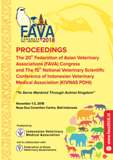IS-24 Zoonotic Wildlife Parasites in Southeast Asia and Their Global Implications
Abstract
Domestic animals and wildlife harbour a number of zoonotic pathogens of veterinary and public health concern. Approximately 75% of the emerging human infectious have a sylvatic cycle and wild animals are known to be efficient reservoirs of these infections. In addition, wild animals in the peri-urban setting act as efficient sources of infection for domestic animals including livestock. In Southeast Asia, the increasing destruction of natural habitats and the escalating trend in land use change has narrowed the disease transmission interface between humans, domestic animals and wildlife The complex interaction between the zoonotic pathogens, humans and animals, the arthropod vectors or intermediate hosts, and the environment, pose a serious challenge for the control and prevention of these zoonotic diseases. In many instances, this is confounded by the paucity of sound epidemiological data.
In Southeast Asia, wild and domestic animals including livestock are hosts to a myriad of parasites of which a number are zoonotic. These pathogens may be transmitted to humans either through an invertebrate vector or intermediate hosts, or by ingestion of the infective stages. While these parasites are endemic to the region, they pose a serious threat to visitors and may have negative impacts to the tourism industry. Of pivotal concern are two protozoan parasites which cause zoonotic primate malaria (Plasmodium knowlesi), and human muscular and enteric sarcocystosis (Sarcocystis spp.). The major natural reservoir host for P. knowlesi are the Long-tailed Macaques (Macaca fascicularis) which is the most common and widespread species of non-human primate in Southeast Asia. This apicomplexan haemoparasites is efficiently transmitted from macaques to humans by Anopheles mosquitoes. Zoonotic primate malaria is now considered the most common and most deadly form of human malaria in many parts of Southeast Asia.
Sarcocystosis is transmitted by ingestion of the Sarcocystis cystic tissue stages present in meat or oocysts in the environment. The life cycle of the parasite involves intermediate and definitive hosts of which humans may assume both roles with varying pathological consequences. While the disease may be self-limiting, muscular infections can cause considerable clinical signs in humans. Both these protozoan parasites have global implications as they are known to infect travellers visiting the region. As such, it is necessary that veterinarians and public health workers be aware of these potentially fatal zoonotic parasites of our local wildlife and domestic animals, in order to facilitate timely and accurate diagnosis, treatment and control measures.

